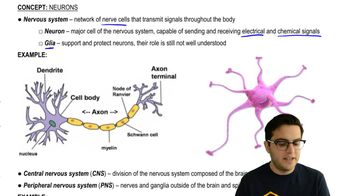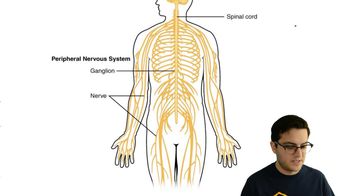Neurons and Action Potentials quiz Flashcards
 Back
BackTerms in this set (19)
What are the two main components of the nervous system?
The central nervous system (CNS) and the peripheral nervous system (PNS).
What is the primary function of neurons in the nervous system?
Neurons transmit electrical and chemical signals throughout the body.
What role do glial cells play in the nervous system?
Glial cells support and protect neurons.
What is the difference between the central nervous system and the peripheral nervous system?
The CNS consists of the brain and spinal cord, while the PNS includes all other nerves projecting from the spine and brain.
What is the function of the axon in a neuron?
The axon transmits electrical signals from the cell body to the axon terminal.
What is a synapse?
A synapse is the connection between the axon terminal of one neuron and the dendrites of another neuron.
What are neurotransmitters?
Neurotransmitters are chemical signals released across the synapse to bind to receptors on the dendrites of another neuron.
What is the role of the sodium-potassium pump in neurons?
The sodium-potassium pump uses ATP to actively transport 3 sodium ions out of the cell and 2 potassium ions into the cell, helping to maintain the membrane potential.
What is an action potential?
An action potential is a transient shift in membrane potential that propagates an electrical signal along the axon.
What is the significance of myelination in neurons?
Myelination, provided by glial cells, insulates the axon and speeds up the propagation of action potentials.
What are the nodes of Ranvier?
Nodes of Ranvier are gaps in the myelin sheath where ion channels are concentrated, allowing for saltatory conduction of action potentials.
What is the difference between ligand-gated and voltage-gated ion channels?
Ligand-gated ion channels open in response to ligand binding, while voltage-gated ion channels open in response to changes in membrane potential.
What is the resting membrane potential of a neuron?
The resting membrane potential is the baseline membrane potential of a neuron, typically negative, when the cell is not actively sending signals.
What is the role of calcium ions in neurotransmitter release?
Calcium ions enter the axon terminal through voltage-gated calcium channels, triggering the release of neurotransmitters into the synaptic cleft.
What is the difference between sensory neurons and motor neurons?
Sensory neurons transmit sensory information to the CNS, while motor neurons send signals from the CNS to effector organs like muscles and glands.
- which specialized cells are responsible for transmitting messages throughout the body?Neurons are the specialized cells responsible for transmitting electrical and chemical messages throughout the body.
- which of these causes the release of neurotransmitter molecules?The release of neurotransmitter molecules is caused by the influx of calcium ions into the presynaptic cell, triggered by the arrival of an action potential at the axon terminal.
- which event triggers the creation of an action potential?The creation of an action potential is triggered when the membrane potential of a neuron reaches a specific threshold, causing voltage-gated sodium channels to open and sodium ions to rush into the cell.
- which glial cells remove debris from damaged or dead nervous tissue?Microglia are the glial cells responsible for removing debris from damaged or dead nervous tissue.



